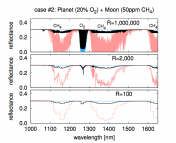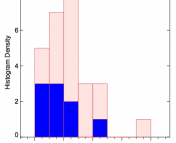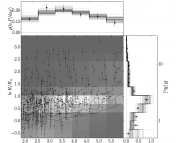Title: Loose Ends for the Exomoon Candidate Host Kepler-1625b
Authors: Alex Teachey, David Kipping, Christopher J. Burke, Ruth Angus, Andrew W. Howard
First Author’s Institution: Department of Astronomy, Columbia University, 550 W 120th Street, New York, NY
Status: Submitted to the arXiv, open access
Where are the moons?
If we’ve found so many planets, why haven’t we found any moons? It is now widely accepted that there are more planets than stars. In our own solar system moons outnumber planets 12 to 1 (and thats only the moons we know of!). By extension, it would make sense for moons to exist around exoplanets. However it is hard enough to find exoplanets at all. Finding an exomoon, then, is even more difficult, and requires the most precise measurements available.
A first candidate for an exomoon was put forth back in a 2018 paper (hereafter T18) by today’s authors. The moon-like signal was first noticed in Kepler space telescope data of the gas-giant Kepler-1625b, which itself orbits in the habitable zone of its sun-like parent star. When observing the planetary transit of Kepler-1625b, the authors noticed a second, fainter transit trailing the planetary transit, as if it was being followed by a smaller object, such as an exomoon! The authors followed up with observations from the Hubble Space Telescope (HST), which is four times more precise than Kepler. Using HST, they found a clearer moon-like transit signal, and also noticed that the planetary transit occured 77.8 minutes earlier than expected. This change in transit time is called a ‘Transit Timing Variation‘ (TTV), and is indicative of another mass in the system, be it a planet or an exomoon, ‘tugging’ on the transiting planet.
Because the candidate signal was so faint, the original research was treated with a great deal of caution, and has drawn a lot of attention to its methods. Today’s paper aims to address some of the possible reasons the detection could be a false-positive, as well as a recent paper by Kreidberg et al. (hereafter K19) re-evaluating the signal from the HST and drawing the conclusion that there is no moon signal at all.
Is the dip an artefact of the data correction?
T18 originally corrected (or ‘detrended’) long term trends in the transit signal using a number of functions. The authors consider whether their original approach was too simple, and try using some more complex functions (see Figure 1). These new functions remove the moon-like transit from the signal, although to some degree this is expected, as more complex models are more likely to remove faint signals. This highlights how small the signal is, and how hard it is to get a lock on it.

Is the dip due to stellar activity?
Stars that exhibit starspots on their surface due to magnetic activity can cause periodic dips in a light curve as starspots rotate in and out of view. If one of these spots caused the moon-like transit signal, we would expect to see it repeated in observations of the star. Looking at random segments of Kepler observations, the authors fit a dip the same duration and depth of that of the candidate exomoon. This was repeated for 100,000 random segments of data, and a dip similar to the moon-like transit was found in 3.8% of cases. This could be due to white noise on the data, and that this may not be the case for the more precise HST data. Overall, they conclude that there is no explicit evidence that activity is an explanation for the signal.
Are the dip and TTV caused by a planet in the system?
Another possible scenario is that the dip and TTV are caused by a second transiting planet. The authors calculate the probability that a transit remained undetected in Kepler data, but appears in the 38 days of HST data. Taking into account that this hypothetical planet must also cause the TTV signal, they find that it would need to have an orbital period of ~ 144 days, with a probability of <0.75% (see Figure 2). Given these low odds, the authors conclude that a second planet is less likely than a moon.

Most importantly: can the detection be reproduced by other scientists?
The most principle validation of any scientific discovery is its reproducibility. When K19 reevaluated the raw HST data with their own tried and tested data pipeline, they discovered that a model of a planet transit without a moon provided a better fit to the data, suggesting that the moon-like dip is an artefact of T18’s data reduction process. K19 make multiple changes to their pipeline which don’t end up changing their conclusion. In their response, today’s authors note that K19’s method slightly increases the scatter on the data compared to theirs, possibly masking the signal, although they are unsure why this is. It is suggested that a step in K19’s process, which accounts for the presence of a planetary transit, may accidentally remove or hide the transit signal. Finally the authors note that a recent paper by Heller et al. does recover the moon-like dip, although inconclusively.
So… what’s next?
As it stands, the original exomoon transit has been validated as well as disproven by other scientists. This highlights the extreme precision required to detect even a large exomoon. Today’s authors suggest that radial velocity measurements (to confirm or deny the planet hypothesis) may be the next step. As K19 argues, resources would be better spent on other science targets (in fact, proposals to observe Kepler-1625b-i again with HST have been rejected). Finally, the signal popping in and out of existence depending on the data pipeline shows that the precision necessary to detect an exomoon is pushing right up against the limits of the current abilities of science. As today’s authors conclude, properly confirming the existence of exomoons may have to wait for the advent of additional and improved space-based surveys.
Note: I have tried my best to discuss todays paper in an unbiased manner. For the full picture, make sure to check out the papers discussed, and discussions by the authors themselves here and here.




